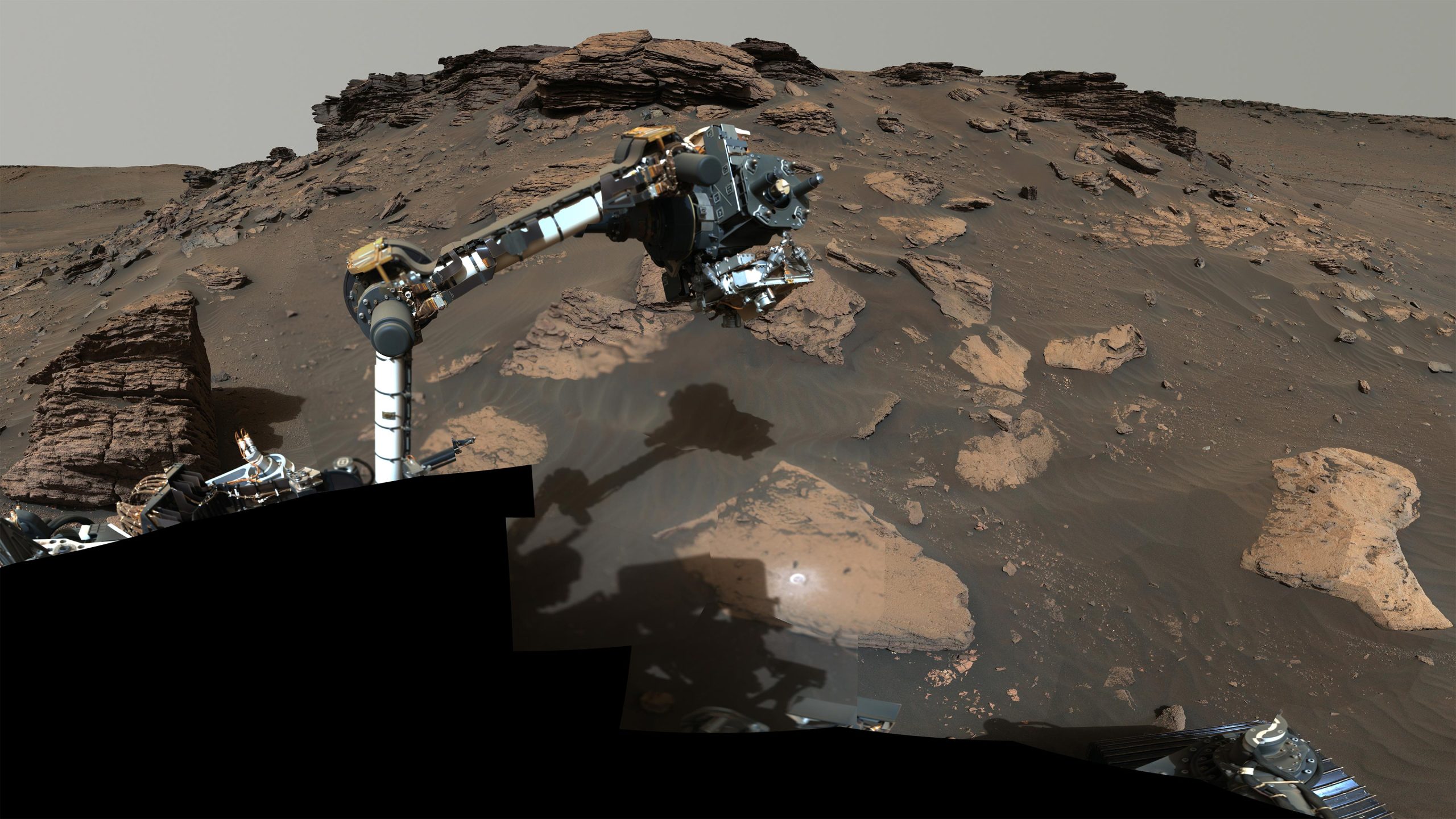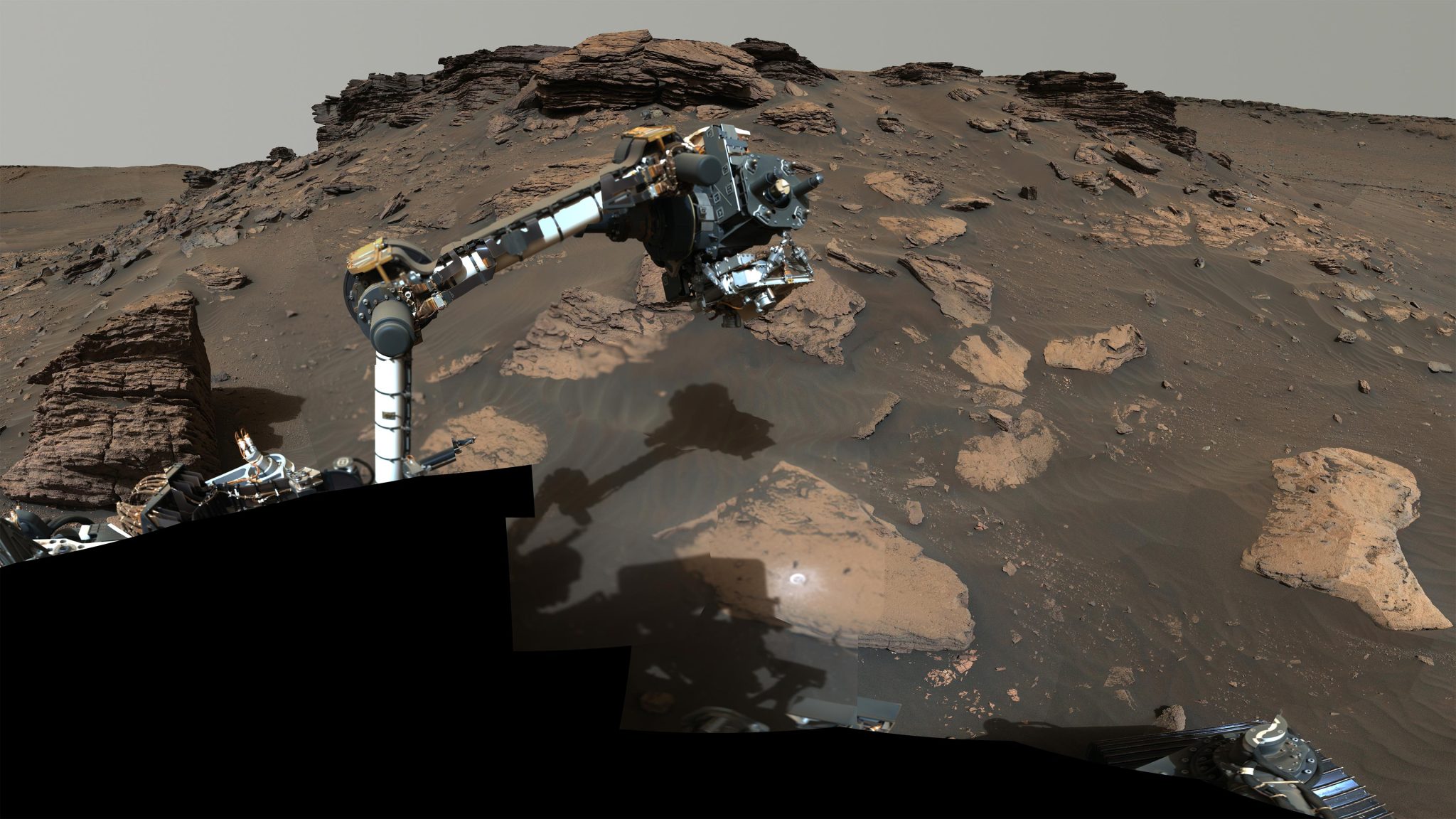

Spațiul de lucru cu perseverență la Skinner Ridge: Roverul NASA își pune brațul robotic funcțional în jurul unui afloriment stâncos numit „Skinner Ridge” din craterul Jezero de pe Marte. Compus din mai multe imagini, acest mozaic prezintă roci sedimentare stratificate care se confruntă cu o stâncă din deltă, precum și unul dintre locurile în care roverul a răzuit un petic circular pentru a analiza formarea rocii. Credit: NASA/JPL-Caltech/MSSS
Roverul Perseverance al NASA investighează terenul bogat din punct de vedere geologic al lui Marte
Cele mai recente descoperiri oferă mai multe detalii despre o regiune a Planetei Roșii care are un trecut apos și oferă mostre promițătoare pentru[{” attribute=””>NASA-ESA Mars Sample Return campaign.
NASA’s Perseverance rover, which is well into its second science campaign, is collecting rock-core samples from features within an area that scientists have long considered to be a top prospect for finding signs of ancient microbial life on Mars. Since July 7 the rover has collected four samples from an ancient river delta in the Red Planet’s Jezero Crater, bringing the total count of scientifically compelling rock samples to 12.
“We picked the Jezero Crater for Perseverance to explore because we thought it had the best chance of providing scientifically excellent samples – and now we know we sent the rover to the right location,” said Thomas Zurbuchen, NASA’s associate administrator for science in Washington. “These first two science campaigns have yielded an amazing diversity of samples to bring back to Earth by the Mars Sample Return campaign.”
Jezero Crater, which is 28 miles (45 kilometers) wide, hosts a delta – an ancient fan-shaped feature that formed about 3.5 billion years ago at the convergence of a Martian river and a lake. Perseverance is currently examining the delta’s sedimentary rocks, which formed when particles of various sizes settled in the once-watery environment. During its first science campaign, the rover surveyed the crater’s floor, finding igneous rock, which forms deep underground from magma or during volcanic activity at the surface.
Perseverență în explorarea craterului Delta Jezero: Roverul Mars Persevere de la NASA a ajuns într-o veche deltă a craterului Jezero, unul dintre cele mai bune locuri de pe Planeta Roșie pentru a căuta posibile semne de viață antică. O deltă este o zonă în care oamenii de știință cred că un râu s-a scurs cândva cu miliarde de ani în urmă într-un lac și a depus sedimente sub forma unui evantai. credit: NASA[{” attribute=””>JPL-Caltech/ASU/MSSS
“The delta, with its diverse sedimentary rocks, contrasts beautifully with the igneous rocks – formed from crystallization of magma – discovered on the crater floor,” said Perseverance project scientist Ken Farley of Caltech in Pasadena, California. “This juxtaposition provides us with a rich understanding of the geologic history after the crater formed and a diverse sample suite. For example, we found a sandstone that carries grains and rock fragments created far from Jezero Crater – and a mudstone that includes intriguing organic compounds.”
A notable rock about 3 feet (1 meter) wide has been given the name “Wildcat Ridge.” It likely formed billions of years ago as mud and fine sand settled in an evaporating saltwater lake. On July 20, the rover abraded some of the surface of Wildcat Ridge. This allowed it to analyze the area with a sophisticated scientific instrument called Scanning Habitable Environments with Raman & Luminescence for Organics & Chemicals, or SHERLOC.
According to SHERLOC’s analysis, the samples include a class of organic molecules that are spatially correlated with those of sulfate minerals. Sulfate minerals found in layers of sedimentary rock can yield important details about the aqueous environments in which they formed.

Two Perseverance Sampling Locations in Jezero’s Delta: NASA’s Perseverance rover collected rock samples for possible return to Earth in the future from two locations seen in this image of Mars’ Jezero Crater: “Wildcat Ridge” (lower left) and “Skinner Ridge” (upper right). Credits: NASA/JPL-Caltech/ASU/MSSS
What Is Organic Matter?
Organic molecules consist of a wide variety of compounds made primarily of carbon and they usually also include hydrogen and oxygen atoms. In addition, they can contain other elements, such as nitrogen, phosphorus, and sulfur. Although there are chemical processes that produce these molecules that don’t require life, some of these compounds are the chemical building blocks of life. The presence of these specific molecules is considered to be a possible biosignature – a substance or structure that could be evidence of past life but may also have been produced without the presence of life.
In 2013, NASA’s Curiosity Mars rover found evidence of organic matter in rock-powder samples, and Perseverance has detected organics in Jezero Crater before. But unlike that previous discovery, this latest detection was made in an area where, in the distant past, sediment and salts were deposited into a lake under conditions in which life could have potentially existed. In its analysis of Wildcat Ridge, the SHERLOC instrument recorded the most abundant organic detections on the mission thus far.
“In the distant past, the sand, mud, and salts that now make up the Wildcat Ridge sample were deposited under conditions where life could potentially have thrived,” said Farley. “The fact the organic matter was found in such a sedimentary rock – known for preserving fossils of ancient life here on Earth – is important. However, as capable as our instruments aboard Perseverance are, further conclusions regarding what is contained in the Wildcat Ridge sample will have to wait until it’s returned to Earth for in-depth study as part of the agency’s Mars Sample Return campaign.”

Sample Collection and Rock Analysis at ‘Wildcat Ridge’: Composed of multiple images from NASA’s Perseverance Mars rover, this mosaic shows a rocky outcrop called “Wildcat Ridge,” where the rover extracted two rock cores and abraded a circular patch to investigate the rock’s composition. Credits: NASA/JPL-Caltech/ASU/MSSS
The first step in the NASA-ESA (European Space Agency) Mars Sample Return campaign began when Perseverance cored its first rock sample in September 2021. Along with its rock-core samples, the rover has collected one atmospheric sample and two witness tubes. All of these are stored in the rover’s belly.
The geologic diversity of the samples already carried in the rover is so good that the rover team is looking into depositing select tubes near the base of the delta in about two months. After depositing the cache, the rover will continue its delta explorations.
“I’ve studied Martian habitability and geology for much of my career and know first-hand the incredible scientific value of returning a carefully collected set of Mars rocks to Earth,” said Laurie Leshin, director of NASA’s Jet Propulsion Laboratory. “That we are weeks from deploying Perseverance’s fascinating samples and mere years from bringing them to Earth so scientists can study them in exquisite detail is truly phenomenal. We will learn so much.”
More About the Mission
Astrobiology is a key objective for Perseverance’s mission on Mars, including caching samples that may contain signs of ancient microbial life. The rover will characterize the planet’s geology and past climate, help pave the way for human exploration of the Red Planet, and be the first mission to collect and cache Martian rock and regolith.
Subsequent NASA missions, in cooperation with ESA, will send spacecraft to Mars to collect these sealed samples from the surface and return them to Earth for in-depth analysis.
The Mars 2020 Perseverance mission is part of NASA’s Moon to Mars exploration approach. This includes crewed Artemis missions to the Moon that will help prepare for human exploration of the Red Planet.
JPL, which is managed for NASA by Caltech, built and manages operations of the Perseverance rover.

„Mândru pasionat al rețelelor sociale. Savant web fără scuze. Guru al internetului. Pasionat de muzică de-o viață. Specialist în călătorii.”





More Stories
Simulările pe supercomputer dezvăluie natura turbulenței în discurile de acumulare a găurilor negre
Trăiește cu anxietate: sfaturi de specialitate despre cum să accepti o afecțiune de sănătate mintală
Noile cercetări asupra unei falii masive de tracțiune sugerează că următorul cutremur mare ar putea fi iminent